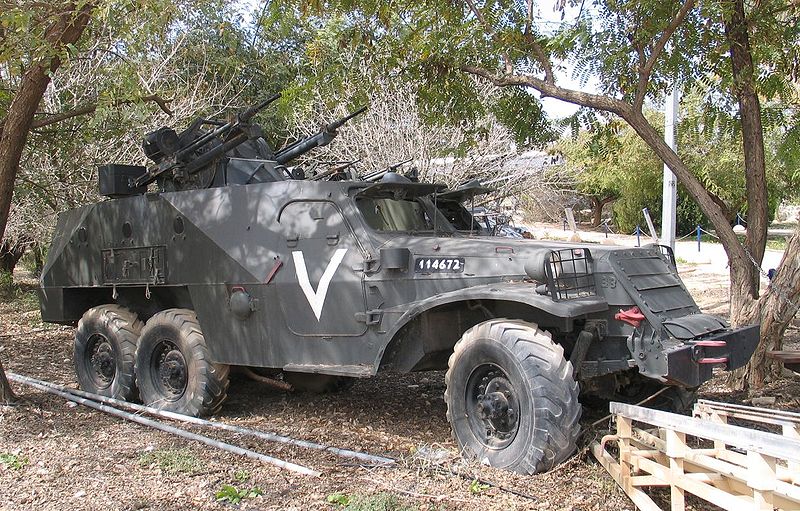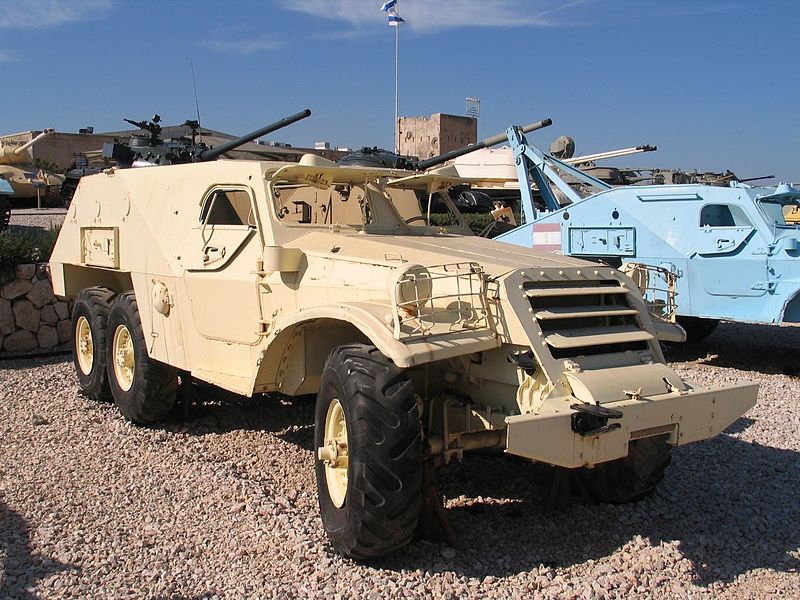The first Russian APC
There was in fact previously a mass-produced light APC in service within the Red army, entering service in 1942: The BA-64. But this vehicle was very small, cramped and only suitable originally as a reconnaissance vehicle. For all the Great Patriotic War duration, Russian soldiers usually traveled to the frontline and on the attack on the flank on regular T-34s, left completely exposed to the enemy fire. Allied forces also experimented in the west with turret-less tanks and converted SPGs, with mixed success. The need for a suitable APC became apparent at the end of the war for all parties engaged. The Soviets already received thousands of US built White M3 Half-Tracks via lend-lease, and studied captured German Sd.Kfz.251 Hanomag half-tracks.They also developed infantry tactics for urban warfare and tank-infantry-coordination attacks with mutual support, which furthermore rendered apparent the lack of APC. A specification of 1946 was issued to provide the Red Army its first purpose-built, all-terrain armored personnel carrier. In November 1946, work started at ZiS plant under the supervision of B. M. Fitterman. The first prototype was completed as early as may 1947, tested, and followed by a further three experimental series, which passed all tests and granted the BTR-152 approval for service on March, 24, 1950.
Design & production
The BTR (which stands for Bronetransporter-/Бронетранспортер or "armored transport" in short "БТР"), was based on the all-terrain Zwas-151 truck (hence the 152). The 6x6 chassis was wrapped in a sloped armor adding 5 tons on it, without any upgrade of the engine or suspensions. Therefore tests demonstrated a poor mobility and speed at first. This was corrected by W. F. Rodionow and N. I. Orłow from the ZiS team which constantly upgraded the model until the end of the production in 1960. By then, the BTR was Soviet's main armored personnel carrier, replaced by a new generation of amphibious 8x8 vehicles started by the BTR-40.Externally, the vehicle borrowed many aspects from US and German half-tracks, although retaining regular coupled tires instead. The general configuration called for a front engine, and the radiator was protected by armored shutters. Behind was located the driver compartment with lateral doors and folding windows, and an open-top compartment with a three-sided sloped section, larger at the center. Pintle mounts were installed on the rear corners and center, as well as six (three per sides) pistol ports, for a total of ten fire points. But the choice of wheels instead of tracks for the rear train was compensated later by an innovation, now passed as a norm among wheeled armored vehicles: The capability or inflate or deflate tires, adapting the ground for better grip and traction on any ground. This system was inaugurated with the BTP-152 K in 1952, which became the main production version.
At the front of the compartment, a fully traversing mount was installed for a 7.62 mm SGMB light machine gun which could be easily swapped for a heavier 12.7 mm DShK 1938/46. The traverse was 45 degrees and elevation between -6 and +24 degrees. The whole armor was sloped, assembled by welding. The driver/co-driver compartment windshield was protected by twin armored shutters with integral vision blocks. They also had periscopes each. Armour thickness ranged from 15 mm (front) to 9 mm (sides), and 4 mm (bottom).
The tires were regular models, unprotected from enemy fire. Some vehicles were equipped with a 5-ton capacity winch and 70 m steel towing cable. Carrying capacity was 1.9 tons of cargo or a half infantry platoon. They can exit from rear doors or jump over the sides. The first serie based on the original ZiS-151 showed poor off-road capabilities and the engine was overwhelmed by the mass of armor. These issues were addressed later during production when using ZiL-157 components and larger, single tires. The crew lacked protection and a rigid armored top was added during production. It was assumed by Automotive Factory No.2 Zavod imeni Stalina (until 1956), and Automotive Factory No.2 Zavod imeni Likhacheva (from 1956 to 1962).
Variants
BTR-152A SPAAG
The main AA variant equipped with a double (ZPTU-2) or quadruple (ZPTU-4) KPVT 14.5 mm heavy machine guns.BTR-152B (1952)
An artillery command version fitted with a front-mounted winch and inaugurating an external tires pressure regulation system.BTR-152V (1955)
Upgraded production version based on the ZIL-157 with a front-mounted winch and external tires pressure regulation system.BTR-152V1 (1957)
Sub-variant fitted with night vision equipment and improved tire pressure system. The V2 had no winch.BTR-152K (1959)
Last variant fitted with night vision, armored hard-top with three big hatches, filtering/ventilating and internal tires pressure system.BTR-152U (1959)
Command version derived from the 152K, fitted with long range antennae, staff equipment and additional trailer. Two sub-variants.Type 56
The license-built Chinese version.SPW 152
The East-German version.The BTR-152 in active service
First official appearance was reported in may 1951 at the Moskow military parade on the red square. It entered service with armored formations until 1965-70 when it was phased out by the all-better BTR-60 but remains in service until 1993 for various duties with the Soviet, then Russian army. Auxiliary duties comprised ambulance, command vehicles and mobile radio stations. The first action came with the 1956 Hungarian uprising. Others saw action with the Soviet invasion of Czechoslovakia in 1968. Hundreds were sold to Egypt and Syria, seeing action in 1967 and 1973 wars.Many were captured by the Israeli which in turn gave many to various Lebanon militias engaged against the PLO. The Chinese and North Korean used some (then produced in China under license as the Type 56) and the North Vietnamese also used these in operations during the Viet-Nam war, especially the Invasion of 1965 and Têt offensive in 1969. The BTR-152 was also largely exported and used by most nations affiliated to the Warsaw pact and about fifty non-aligned countries, participating in many local conflicts, especially in Africa. List of former users in Europe included Poland, East Germany, Yugoslavia, Bulgaria, Albania, Hungary, Estonia, and Romania. East Germany developed a version of its own, produced locally, the SPW-152 (Schützenpanzerwagen-152).
These also saw service in Asia with Laos and Cambodia, China, Vietnam (reunified), North Korea, Sri Lanka. In Africa, operators included Angola, Equ.Guinea, Guinea and Guinea-Bissau, Ethiopia, Mali, Mozambique, Rep. of Congo, Somaliland, Sudan, Syria, Tanzania, Uganda, Yemen and Zimbabwe. Egypt, Syria, Algeria, Cyprus, Cuba, Afghanistan, Mongolia, India, but also Iran and Irak in the middle east are former operators. The only country in America operating these vehicles is the Nicaraguan army.
BTR-152 related links
The BTR-152 on WikipediaA specialized website on the BTR-152 (in Russian)
BTR-152 specifications |
|
| Dimensions (L-w-h) | 6.55 x 2.32 x 2.04 m (21.4 x 7.6 x 6.7 in) |
| Total weight, battle ready | 9.91 Tons (18 000 lbs) |
| Crew | 2+16 (later 2+13 on 152U) |
| Propulsion | 4-cyl GAZ AA 40 bhp (30 kW) |
| Speed (land/water) | 42 km/h (26 mph) |
| Range (road/off road) | 120 km (74.5 mi) |
| Armament | 1x DTM 7.62 mm (0.3 in) MG, 2500 rounds or Heavy 12.7 mm DSHK AA MG - see notes. |
| Armor | 4 to 15 mm (0.24-0.39 in) |
| Total production | Approx. 15 000 |

Standard Soviet Army BTR-152 of the early open-top model, Eastern Germany 1950.

BTR-152 K, 1955.

BTR-152 V1 from an Egyptian infantry division, 1967 war.

BTR-152 V, two tone camouflage, Soviet unit, 1960s.

Modified Irakian BTR-152 K Iran-Irak war 1986 with a 12.7 mm DShK 1938/46.

Standard Soviet Army BTR-A SPAAG, with a twin mount ZPU-2.

BTR-152 V1, North Vietnamese Army, Ho Chi Minh trail, 1969

BTR-152 E, Lebanese Christian Militias, Beyrouth, 1985.
Gallery























Cold War Tanks


































Cold war tanks posters

Cold War Main Battle Tanks

Cold War Soviet Army

